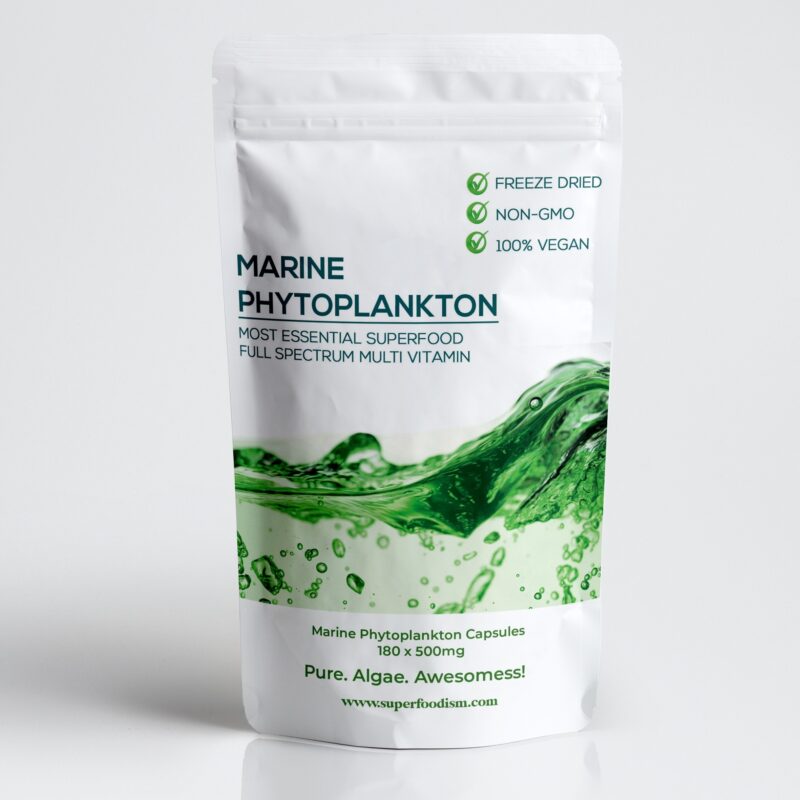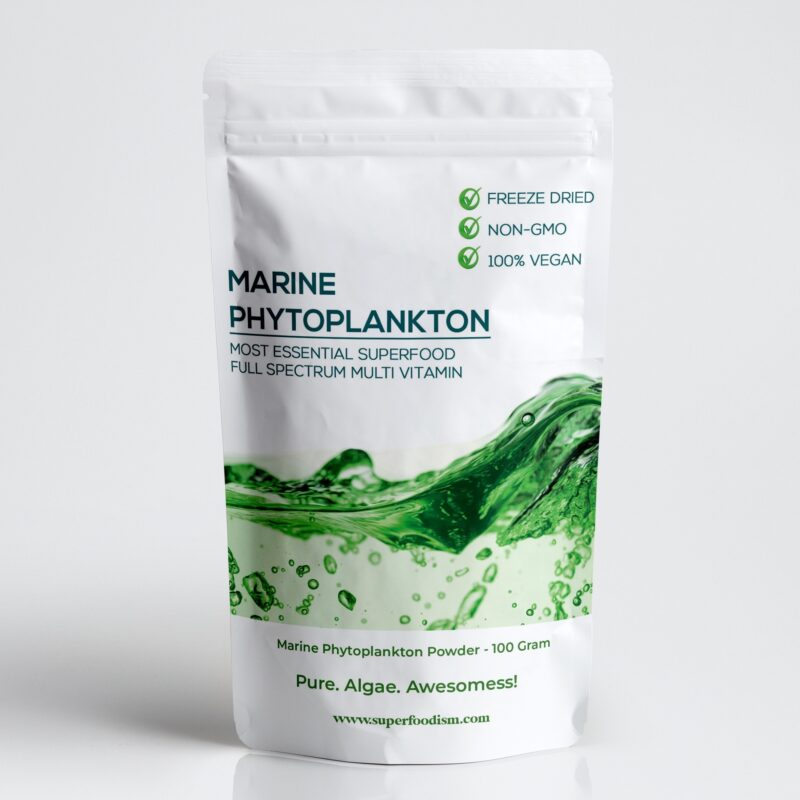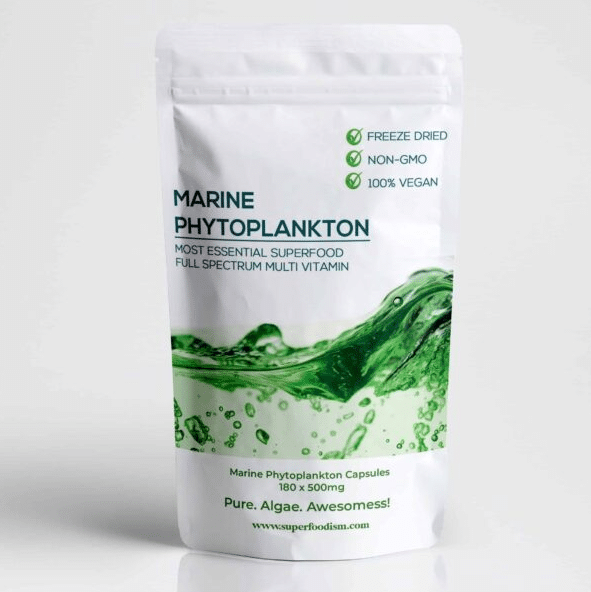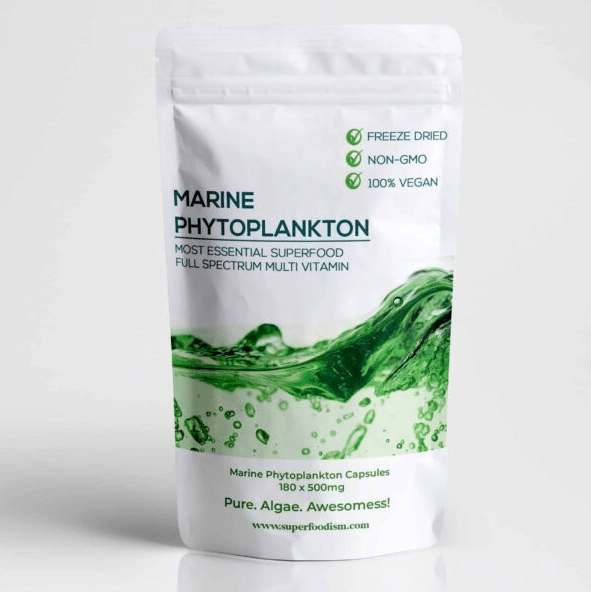Sure thing! Phytoplankton has been around for a while, but it used to be really high-priced because of expensive technology and low production volumes. It just didn’t make sense, both in terms of nutrition and cost. But for a while now, things have changed. We’re thrilled to let you know that you can get marine phytoplankton on this website for a much more reasonable price than elsewhere online. We’re talking about 100% pure Nannochloropsis Gaditana powder or veggie caps. Forget about those diluted and pricey dropper bottles that barely have any actual phytoplankton. What we offer is strictly the real thing, without fillers, binders, or flowing agents!

The Ocean’s Superfood: Marine Phytoplankton
“The future of nutrition is found in the ocean,” said Jacques Yves Cousteau. Indeed, that future has now unfolded. Utilizing modern bio-reactor technology, marine phytoplankton has evolved significantly from its origins in the ocean. After years of being prohibitively priced, this ‘king of superfoods’ is now accessible to all.
The Power of Marine Phytoplankton
Marine phytoplankton stands out as a superfood that should find its place in everyone’s daily routine. Dr. Mark Hyman, a medical doctor and advocate of Functional Medicine, highlights that around 99 percent of people are deficient in omega-3 fatty acids, a deficiency with far-reaching implications for our biochemistry and overall health. Phytoplankton, a rich source of omega-3 fatty acids (EPA), offers a treasure trove of other nutrients. As the foundation of the marine food chain, it boasts an impressive array of proteins, chlorophyll, amino acids, minerals, pigments, enzymes, and trace elements.
Advances in Accessibility
Traditionally a crucial food source for marine animals, recent advancements in photobioreactor technology have made phytoplankton accessible to humans directly. This technology eliminates the need to rely strictly on fish or fish oil, offering a contamination-free product with high bioavailability. This development is particularly promising for vegetarians and vegans. Phytoplankton provides a viable alternative for obtaining essential nutrients without the ethical concerns or potential contaminants associated with fish products.
Nannochloropsis Gaditana: The Optimal Choice
Among the vast array of phytoplankton species, only a select few are fit for human consumption. Extensive research by microbiologists and nutritionists has identified Nannochloropsis Gaditana as a standout species due to its exceptional nutritional profile. Cultivated in technologically advanced photo-bioreactors using natural sunlight and photosynthesis, this phytoplankton species grows uncontested, eventually forming the biomass that is harvested and dried.
Welcome to the era where the nutritional powerhouse of the ocean is not just a concept but a reality for everyone. With marine phytoplankton now widely available, incorporating this superfood into daily diets can significantly improve overall health and well-being.
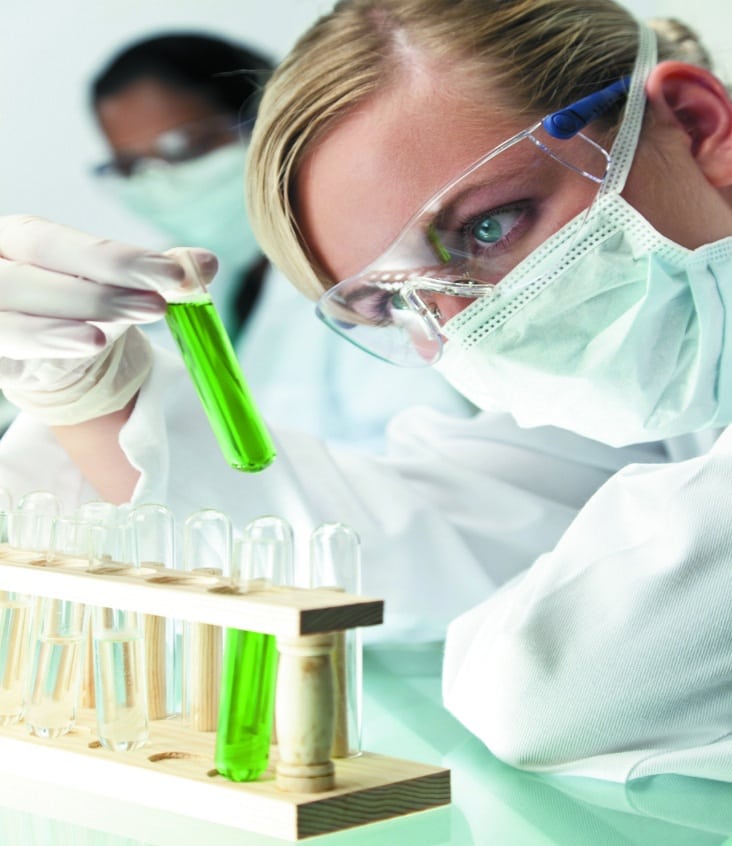
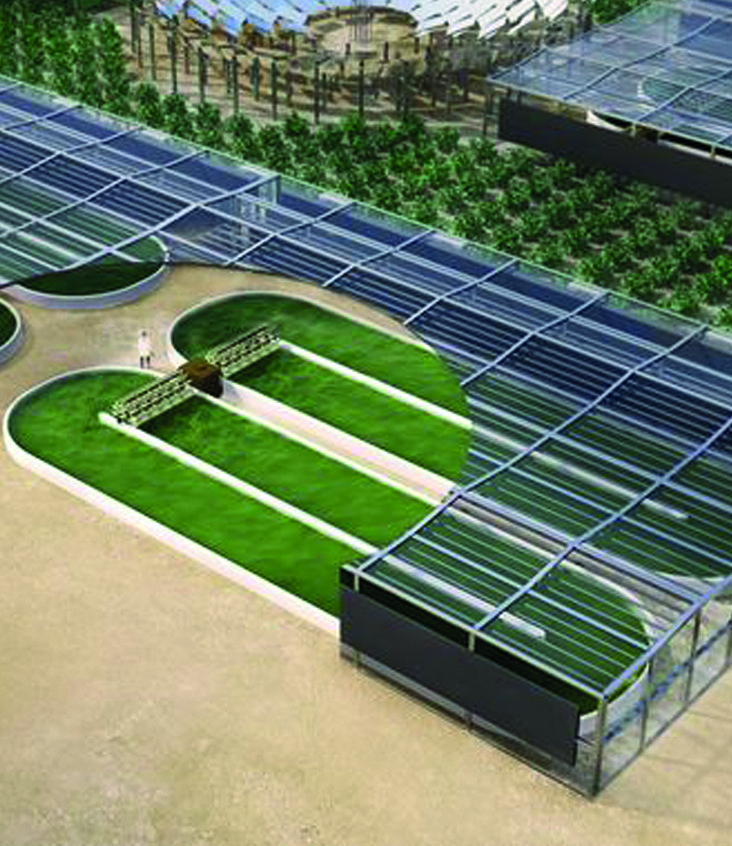
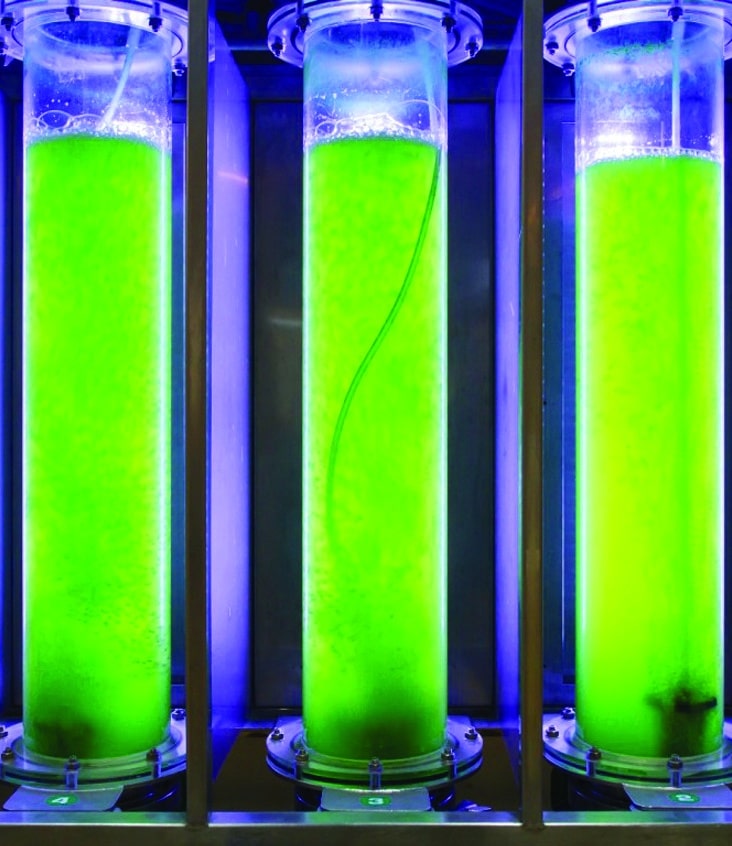
Bio Reactor Technology
Our photo-bioreactor technology ensures a pure and safe product. In simple terms, we continuously supply nutrients, CO2, and oxygen to the reactors, ensuring that the algae have everything they need for optimal growth and development.
Is Marine Phytoplankton Expensive?
Traditionally, most phytoplankton was grown in costly tubular photo-bioreactors, limiting production volumes and driving consumer prices sky-high. Fortunately, those days are now behind us! Our phytoplankton is cultivated in a more traditional ‘open pond’ system, albeit within a controlled greenhouse environment. This greenhouse serves as the photobioreactor, allowing us to meticulously control all growth parameters. The result? High-quality algae at a significantly reduced price.
Now is the time to start prioritizing the well-being of yourself and your loved ones by providing essential nutrients to your body and brain. This revolutionary source comes from a completely clean and sustainable process, marking a new era in nutrition.
Why Choose Phytoplankton?
Phytoplankton is a valuable and comprehensive food source, providing the body with vital nutrients for the production of healthy cells and neurotransmitters. It boasts an alkaline pH, promoting optimal body acidity—a critical factor for good health.
A Quick Look at Marine Phytoplankton’s Nutritional Profile:
- Complete protein (50%)
- Chlorophyll and EPA (healthy omega-3 essential fatty acids)
- Phospholipids (facilitating the absorption of EPA and other omega-3 fatty acids)
- Vitamins, Minerals, and Pigments
- Beta-carotene, Zeaxanthin, Violaxanthin, Antheraxanthin, Vaucheriaxanthin (potent antioxidants)
For maximum benefit, incorporate 3/4 gram or 6/8 capsules of 500 mg daily into your routine.
Featured Products
Omega 3 Fatty Acid EPA
The brain is 60% lipid. It requires a diet rich in omega-3 fatty acids for optimal function.
Chlorofyll
9 out 10 people don’t eat enough vegetables! We say: add more green to your life… It’s easy!
The Importance of Vegetables and Chlorophyll
Everyone knows it’s essential to eat plenty of vegetables. Despite this, less than 10% of Europeans consume the recommended daily amount of fruits and vegetables. One crucial reason to eat enough vegetables is to ensure adequate chlorophyll intake. Chlorophyll, the green pigment found in all plants, is the powerhouse responsible for energy production. In our bodies, chlorophyll acts as a powerful antioxidant.
Naturally, you can find chlorophyll in all green leafy vegetables. However, it is easily destroyed during cooking. To derive maximum benefits, it is better to eat it raw in the form of vegetable juice, salads, or green algae superfoods. Micro-algae such as Spirulina, Chlorella, and Marine Phytoplankton contain more chlorophyll than any other food source, making it easy to get your daily dose of “vegetables.”
The Advantages of Chlorophyll
Chlorophyll is a good source of antioxidants. Antioxidant food substances, such as vitamins A, C, and E, help neutralize harmful molecules (free radicals) that can damage healthy cells. Another important benefit is its role in the production of red blood cells. By making more red blood cells, chlorophyll helps with the growth and maintenance of tissues and aids in healing wounds effectively. It also decontaminates and inhibits the growth of bacteria in the body.
Chlorophyll and chlorophyllin can bind with chemicals that are known carcinogens, including polycyclic aromatic hydrocarbons found in tobacco smoke. They are known to neutralize polluted air when inhaled, making them beneficial for smokers or people living in cities. Another benefit is that chlorophyll works wonders against bad breath. As a deodorizer, it neutralizes odors in the mouth and throat. It also promotes a healthy digestive system, the main reason for bad breath.
Chlorophyll’s Anti-Carcinogenic Properties
According to the U.S. National Institutes of Health (NIH), chlorophyll also has anti-carcinogenic properties. Chlorophyllin (CHL), a water-soluble derivative of chlorophyll, exhibits strong anti-mutagenic activity against a variety of carcinogens. In a 2007 study, 140 trout induced with liver and stomach cancer were fed CHL (2000 ppm), which protected them from these cancers.
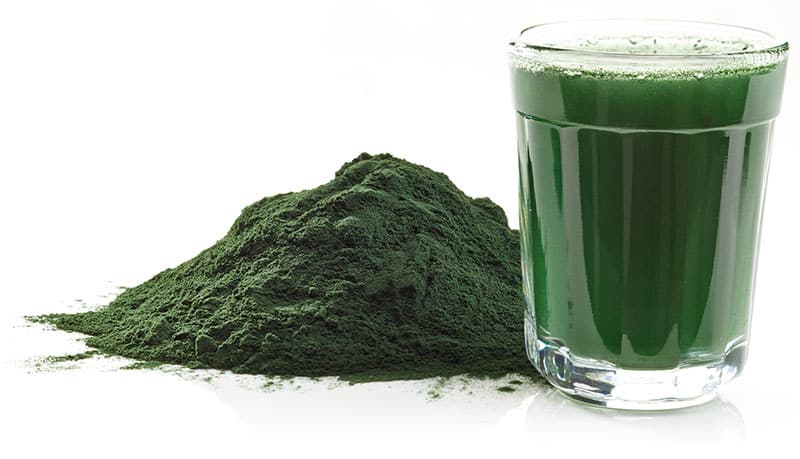
Maintaining healthy, clean blood is essential to preventing illness and the spread of free radicals. The molecular structure of chlorophyll is almost identical to that of hemin, a component of hemoglobin, the protein that carries oxygen in the blood. The only difference is that magnesium (Mg) is at the center of chlorophyll, while iron (Fe) is central to hemin. Scientists have studied the assimilation of chlorophyll in the body and found that at a certain point, magnesium changes to iron, although the exact process remains unknown.
Chlorophyll Supplements
The intake of chlorophyll can be regarded as a “green” blood transfusion. The best way to get chlorophyll in the diet is through supplements like marine phytoplankton, spirulina, or chlorella. These can be easily taken in powdered form in smoothies or as tablets. Another major advantage of chlorophyll is its properties as a chelating agent. It binds with toxic heavy metals in the body and removes them safely. For example, chlorophyll can effectively remove mercury, making it a great option for those with mercury fillings in their teeth or those who have had them removed. Often, a significant amount of mercury is released into the body during this procedure.
For further reading, refer to these studies and articles:
Bio Availability
You are what you eat? Or what you absorb?
Understanding Bioavailability
Bioavailability refers to the ease with which nutrients from the food we eat can be absorbed into our bodies. This “journey” starts with digestion, where the food is broken down to release nutrients. Once freed, the nutrients are absorbed from the digestive tract into the body.
When a nutrient is highly bioavailable, it can be digested and absorbed efficiently and consistently. In contrast, poorly bioavailable nutrients face difficulties in digestion, absorption, or both. Typically, a healthy diet and body function ensure adequate nutrient bioavailability. However, modern agricultural practices and less-than-optimal diets often make it challenging to get enough micronutrients from food alone.
The Role of Supplements
Supplementation can help fill the gaps left by our diets. When choosing supplements, always opt for whole food supplements instead of isolated or synthetic nutrients. Phytoplankton is an excellent example of a whole food supplement.
Why are whole foods better? The components of food are part of a complex balance of nutrients, chemicals, and their interactions within the human body. Overloading the system with large doses of one component can lead to unintended and counterproductive actions and adjustments within these systems.
Micro Algae vs. Fish Oil
Marine phytoplankton offers a sustainable and superior alternative to fish oil. The key nutrient EPA (Eicosapentaenoic acid) achieves optimal bioavailability for the human body when present in the phospholipid portion of fats. Phospholipids are essential for transporting nutrients into your system and directly into your brain.
The EPA in phytoplankton is better absorbed than from fish oils because it can more easily cross the blood-brain barrier, which protects the brain from most foreign substances. This efficient transfer mechanism ensures that essential fats reach your brain, where they are most needed.
When we consume phytoplankton, phospholipids help transport EPA to the cells of our body. Interestingly, the EPA stored in human cells is mainly in the phospholipid form, with only a small amount in the triglyceride form. Fish oils, on the other hand, contain mostly triglycerides and only a small amount of phospholipids, making phytoplankton a more efficient source of omega-3.
Conclusion
Incorporating marine phytoplankton into your diet offers a more effective way to ensure you get enough omega-3 fatty acids. This whole food supplement provides better nutrient absorption and supports overall health more effectively than traditional fish oil supplements.
The BS on PHYTO
Don’t believe the Hype!
Tips for Buying Marine Phytoplankton
When shopping for marine phytoplankton, keep the following points in mind:
- Avoid Dropper Bottles
Don’t buy dropper bottles from any brand. They might only contain 1500mg (1.5 grams) of phytoplankton. At $40 per bottle, you end up paying $26.6 per gram, which equates to $26,600 per kilogram. This pricing might benefit the seller, but it offers zero value to you as a consumer. - Choose Pure Products
Buy only 100% pure Nannochloropsis powder, capsules, or tablets. Ensure your algae supplement contains no fillers, binders, preservatives, or additives. Pure products guarantee you receive the full nutritional benefits without unnecessary extras. - Request a Certificate of Analysis (COA)
Always ask for a Certificate of Analysis (COA). This document provides a complete nutritional breakdown of the product and confirms that heavy metal content is within safety limits and no toxins are present. - Verify the Drying Method
Confirm that the producer uses an appropriate drying method. Excessive heat during drying can significantly reduce vital nutrients. Prefer freeze drying or low-temperature thermal drying over spray drying to retain the nutrient content.
Assessing Value for Money
Consider how much value you get for your money. Historically, consumer prices for phytoplankton have been around €1 per gram. We now offer high-quality phytoplankton for €0.33 per gram. The minimum recommended daily intake is 4 grams, providing 240mg of EPA daily. The daily recommended dose of EPA is 220mg. For €1.30, you can meet your daily requirement, which is half the price of a cup of coffee at your local coffeehouse.
By following these guidelines, you can ensure you purchase high-quality marine phytoplankton that offers excellent value and maximum nutritional benefits.
Common Misconceptions About Phytoplankton
Phytoplankton is often surrounded by misconceptions. Here are some common myths and the truth behind them:
- “Marine Phytoplankton contains every known vitamin and mineral.”
This is a bold and inaccurate statement. While phytoplankton is highly nutritious, it contains 8 of the 13 essential vitamins and 8 out of 16 essential minerals. - “1500mg of marine phytoplankton in a 2-ounce/60ml bottle is highly concentrated and highly potent.”
Although 1500mg may sound like a lot, it’s only 1.5 grams of marine phytoplankton. This is far from concentrated and potent, considering the recommended daily dose is 2ml. Not even the whole dropper provides enough for the day. - “It is especially rich in the vital Omega-3 fatty acids Docosahexaenoic acid (DHA) and Eicosapentaenoic acid (EPA).”
While phytoplankton contains EPA, which the body can convert into DHA, it doesn’t contain significant levels of DHA.
Assessing Value for Money
Consider how much value you get for your money. Historically, consumer prices for phytoplankton have been around €1 per gram. We now offer high-quality phytoplankton for €0.33 per gram. The minimum recommended daily intake is 4 grams, providing 240mg of EPA daily. The daily recommended dose of EPA is 220mg. For €1.30, you can meet your daily requirement, which is half the price of a cup of coffee at your local coffeehouse.
Conclusion
By following these guidelines, you can ensure you purchase high-quality marine phytoplankton that offers excellent value and maximum nutritional benefits. Always be mindful of the product’s purity, the accuracy of the claims made, and the value you receive for your money.
Join our newsletter!
We’ll keep you in the loop on our exciting offers and regularly share fascinating insights about the amazing world of algae and the benefits of a whole food plant-rich diet!
Address
SuperFoodISM
Moezelhavenweg 91 – 1043AM Amsterdam The Netherlands
Call us
(+31)-20-3413410
(+31) 6-46024298
info@superfoodism.com


